A study on high school students’ perceptions of the process of learning to write Emails in English
The present study was carried out to investigate students’
perceptions of the process of learning to write emails in English. The
participants comprised of 100 high school students of grade 11. Data
collection methods include questionnaire, interview and reflective journals.
The study found that students had good awareness of email writing skills in
the classroom. They shared their viewpoints on the process of learning to
write emails in English both negatively and positively, with positive
opinions outweighing negative ones. The findings also revealed that the
respondents had positive attitudes toward email writing skills and tended to
accept their difficulties as motivation in their language classes. Based on the
findings of the study, implications were put forward as to how to teach and
learn to write emails in English effectively.
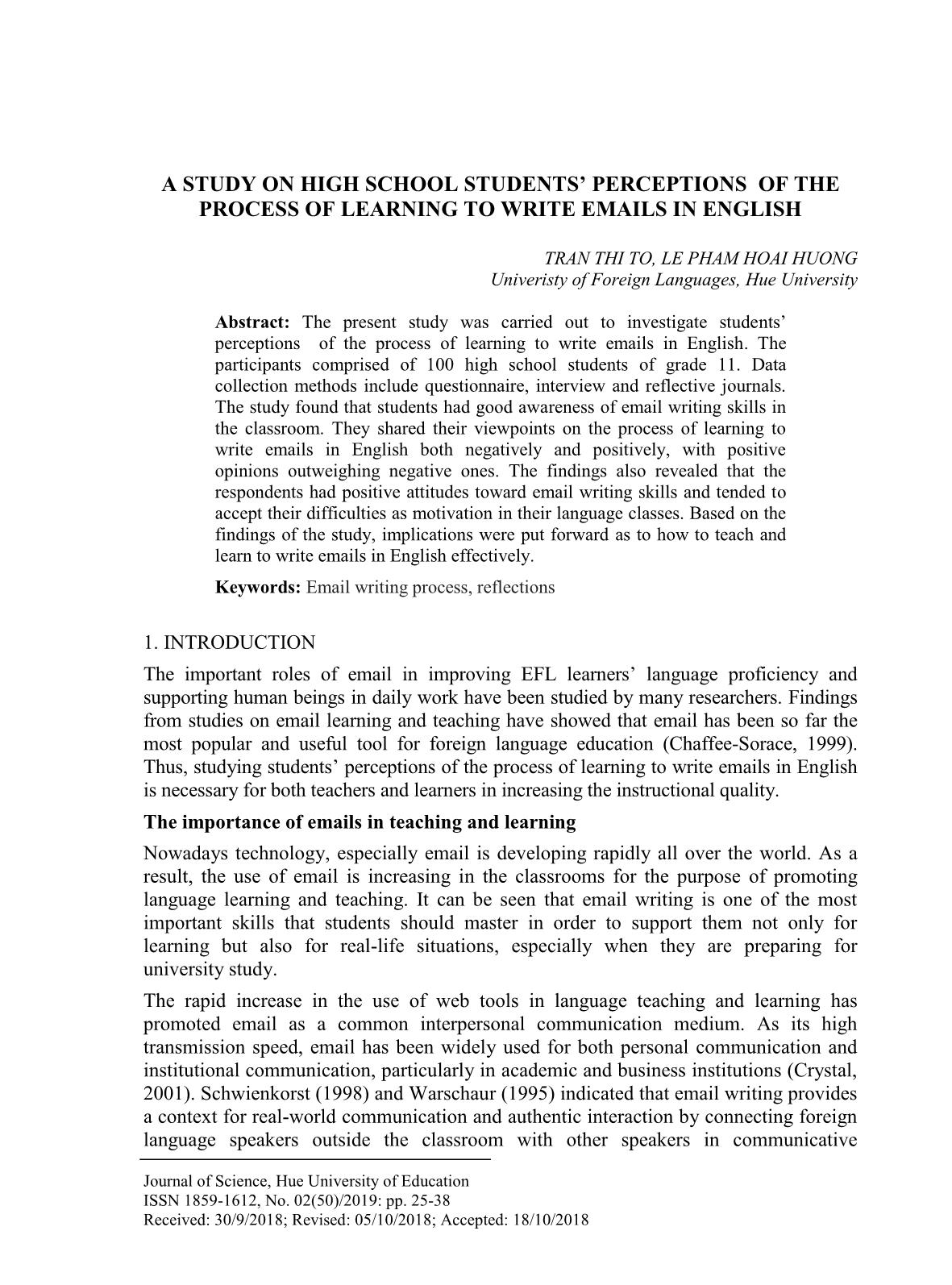
Trang 1

Trang 2
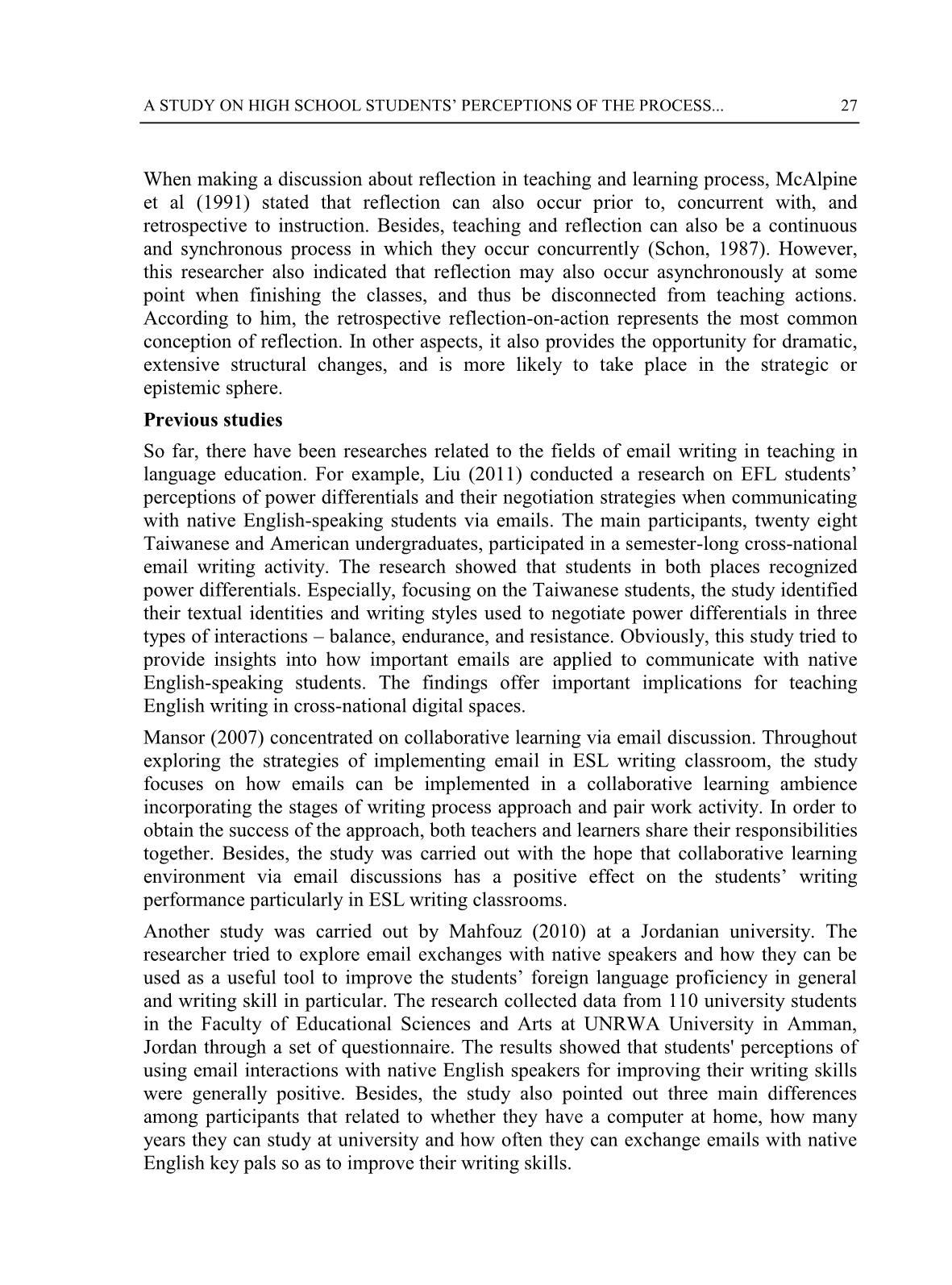
Trang 3
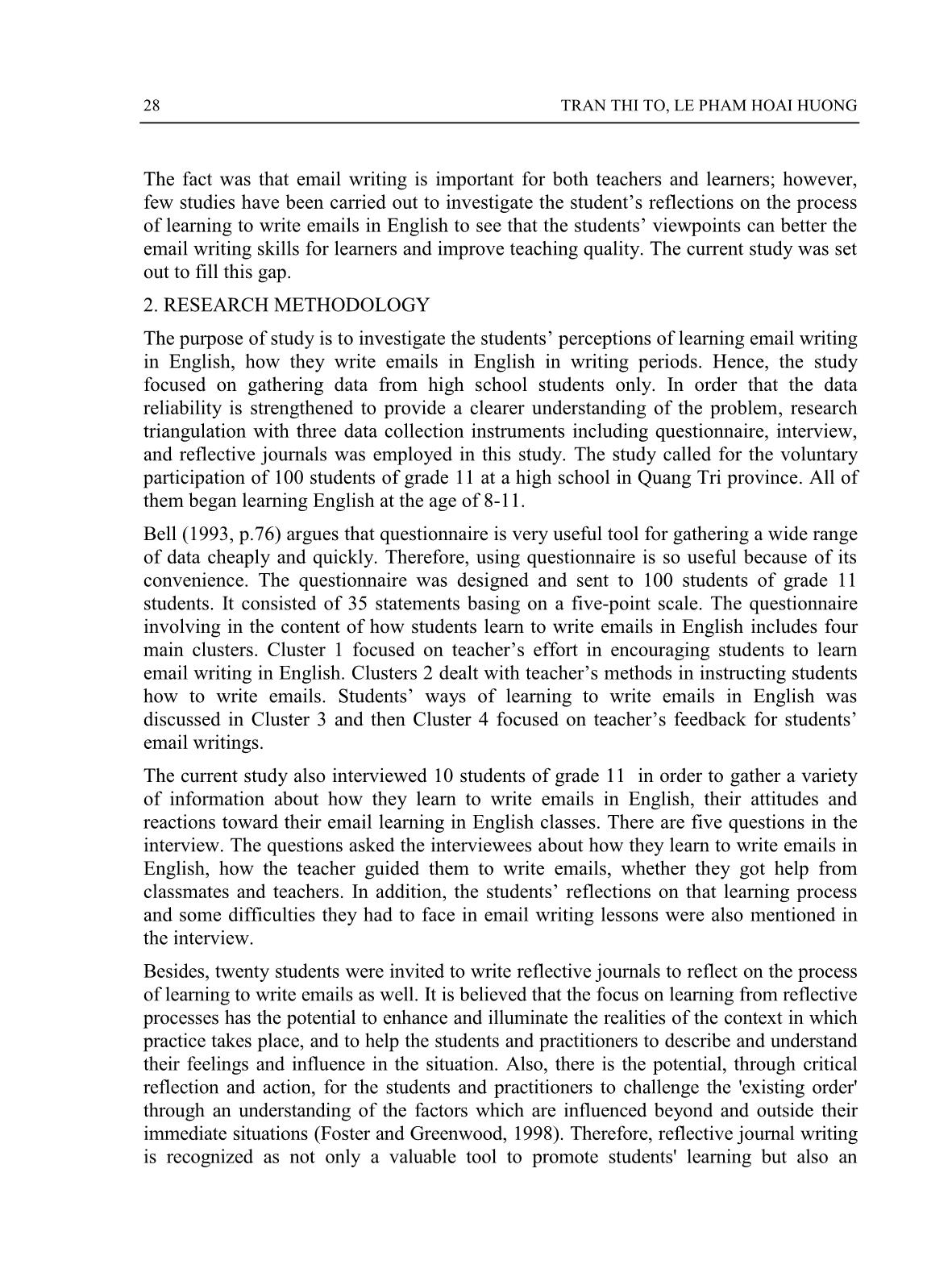
Trang 4
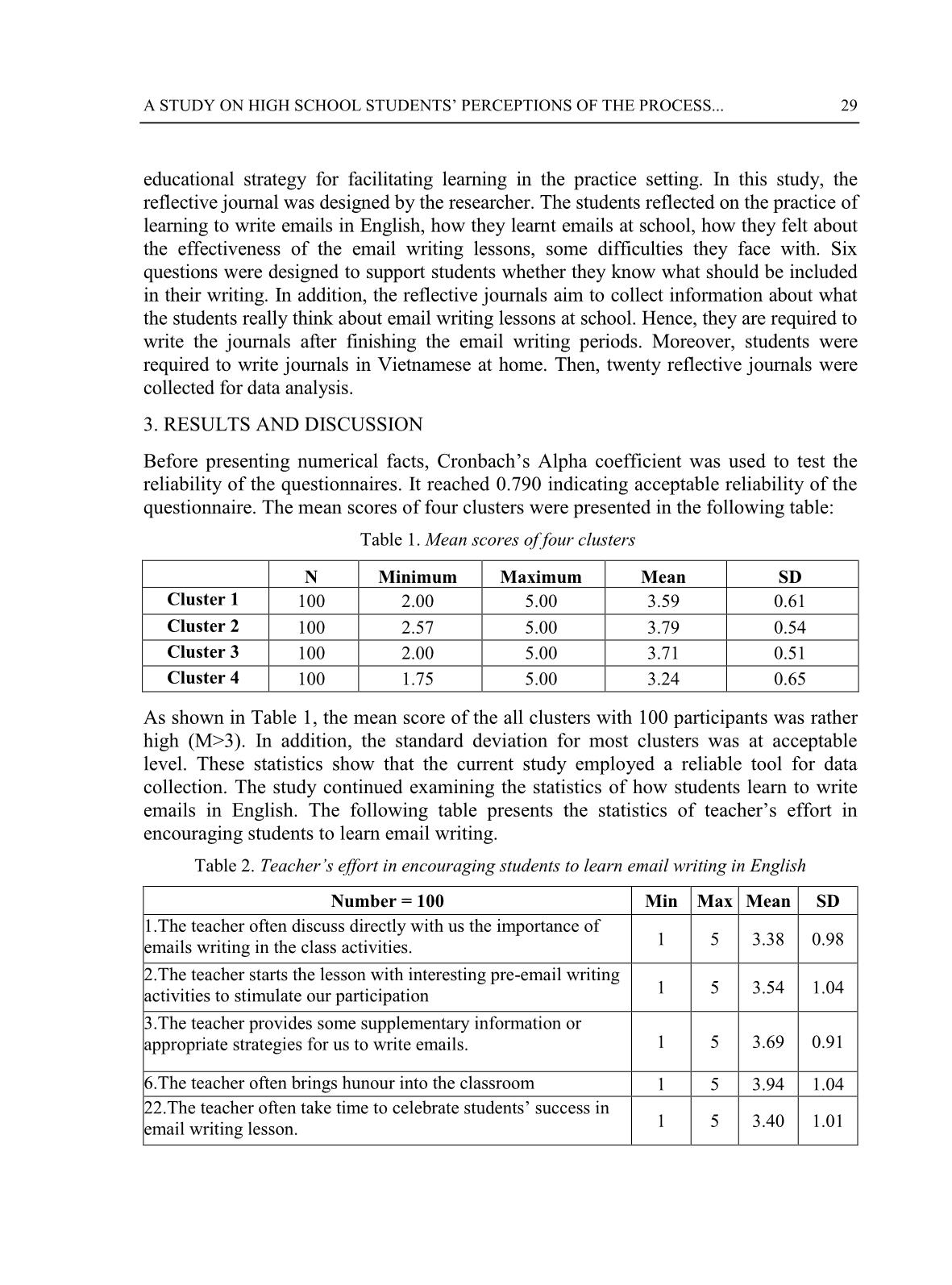
Trang 5
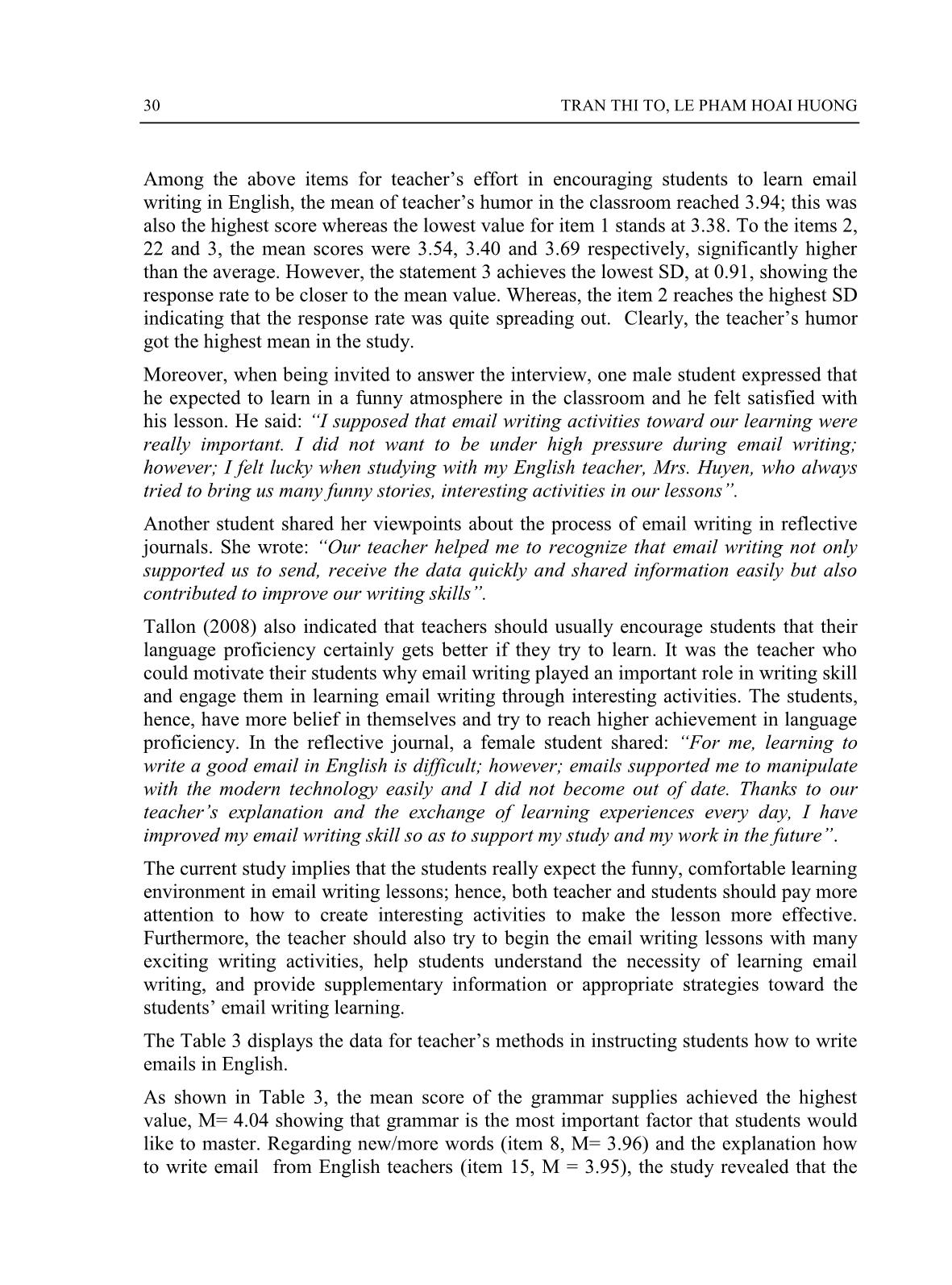
Trang 6
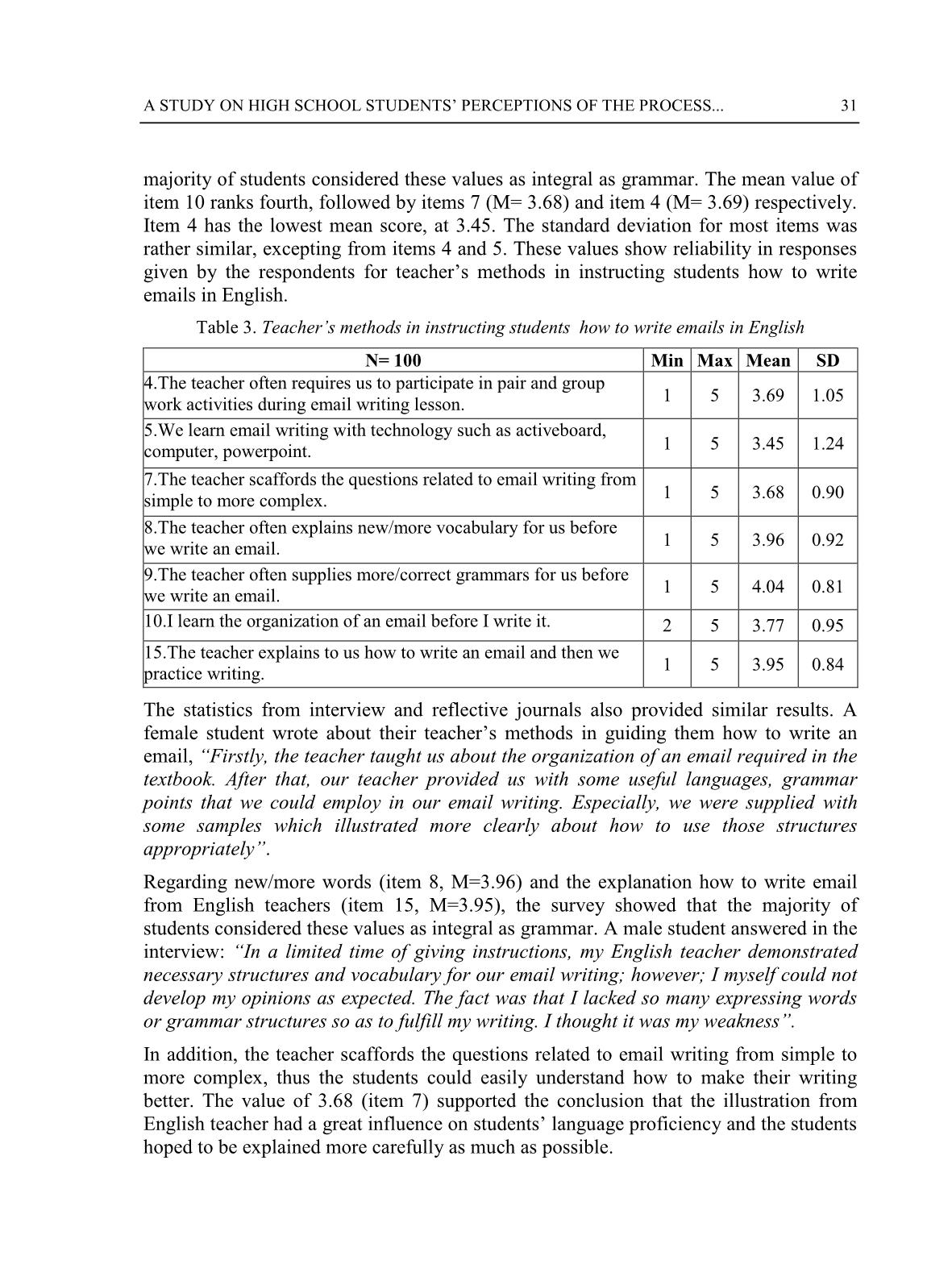
Trang 7
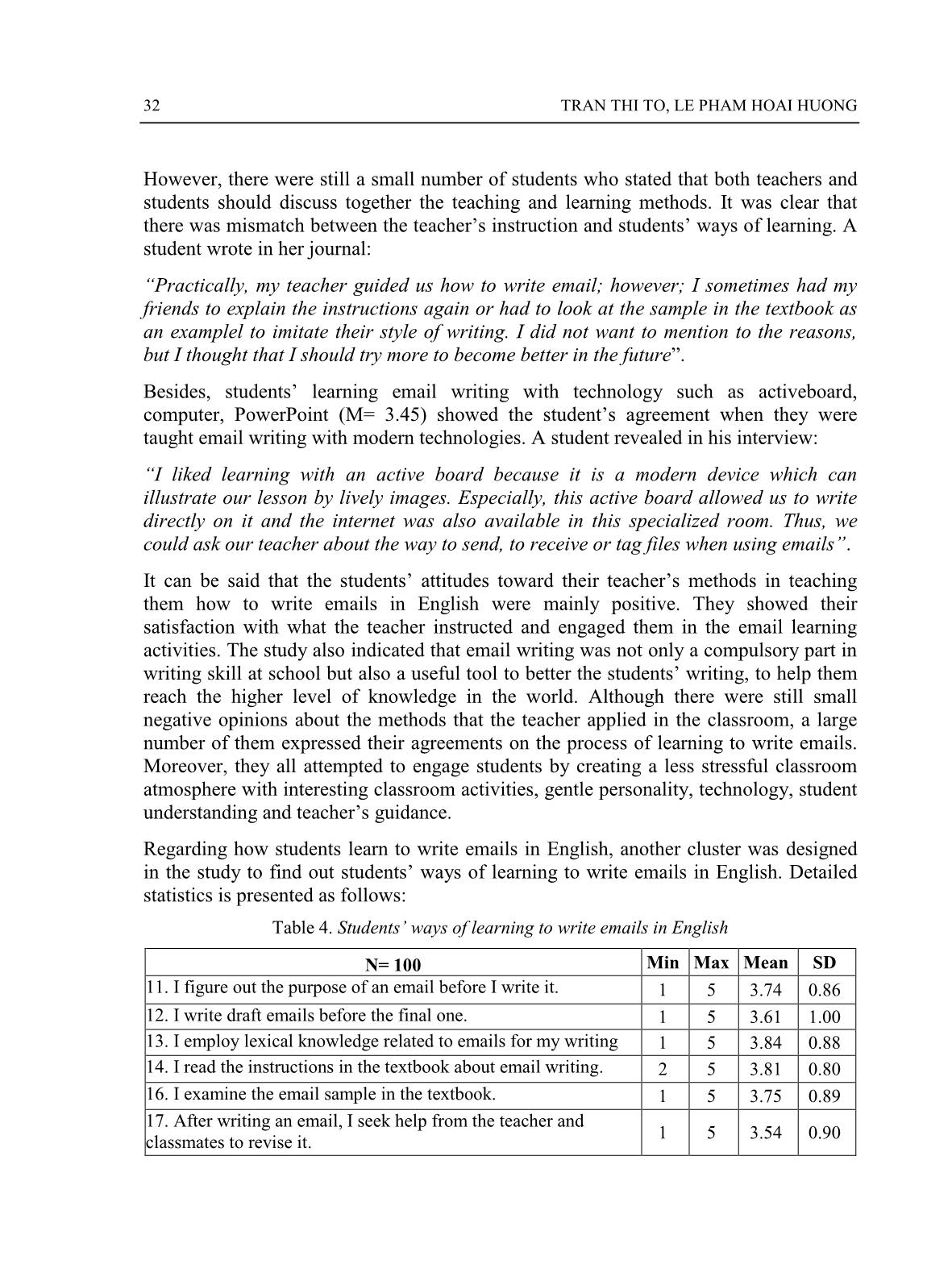
Trang 8
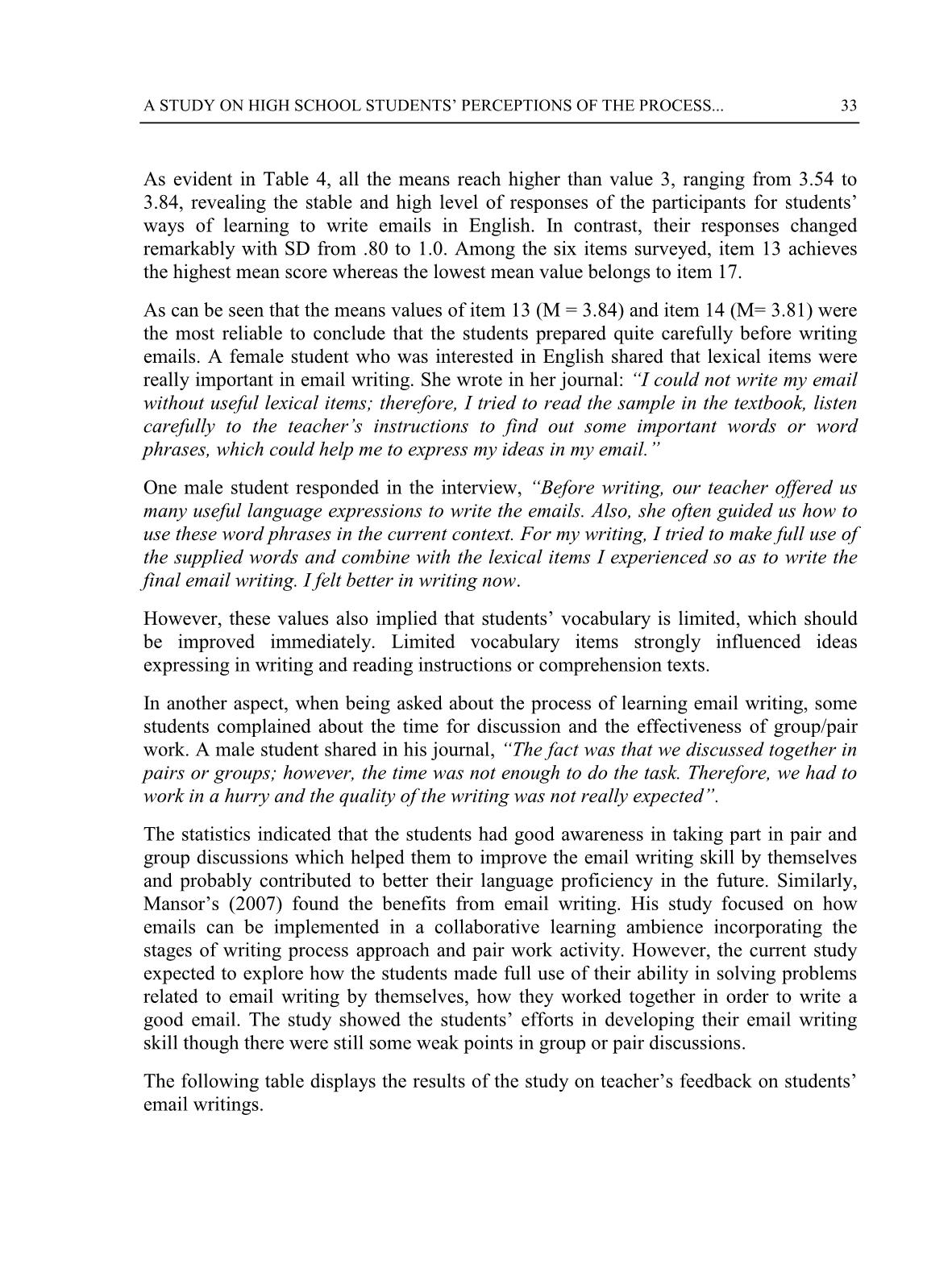
Trang 9
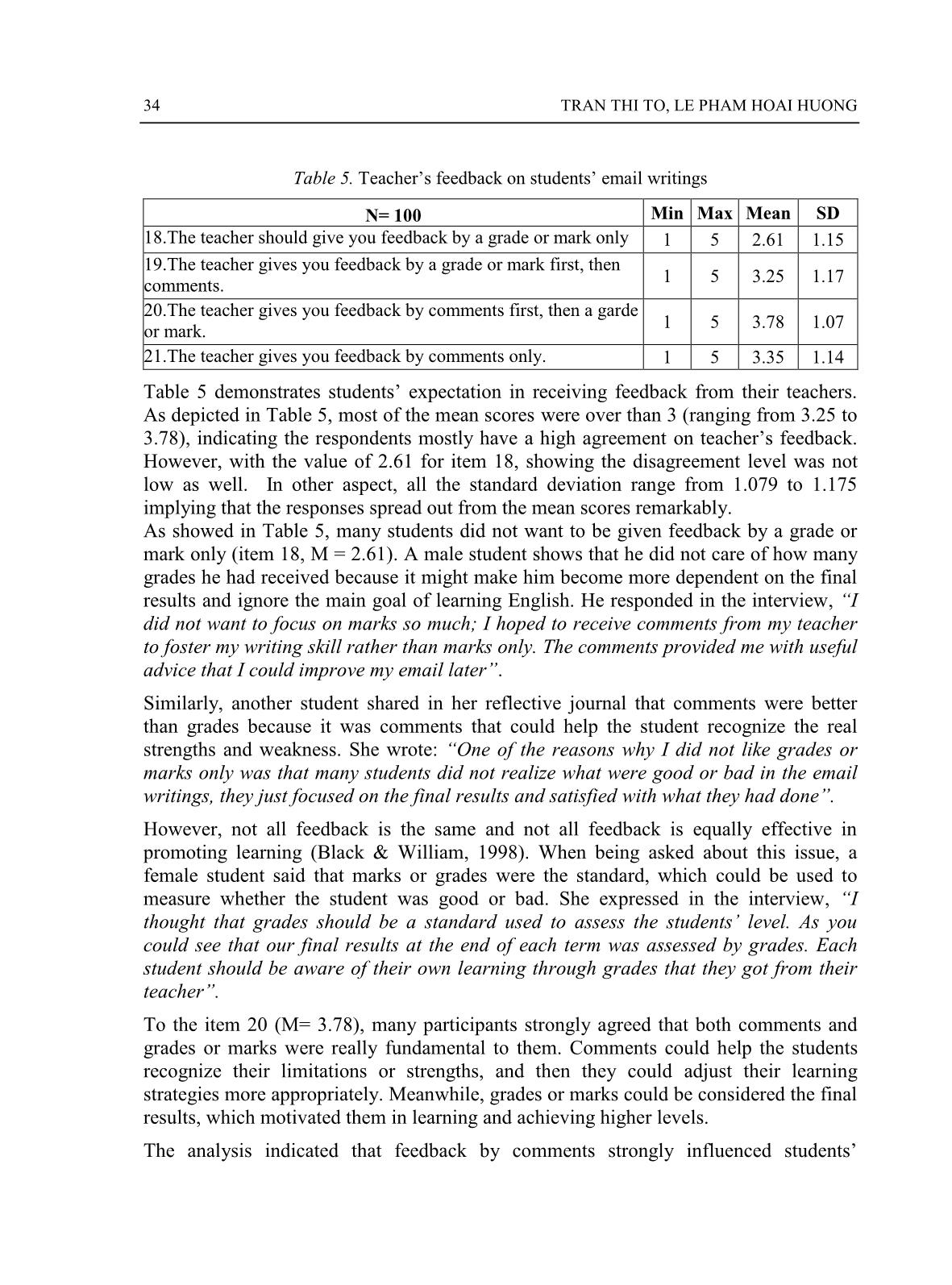
Trang 10
Tải về để xem bản đầy đủ
Tóm tắt nội dung tài liệu: A study on high school students’ perceptions of the process of learning to write Emails in English
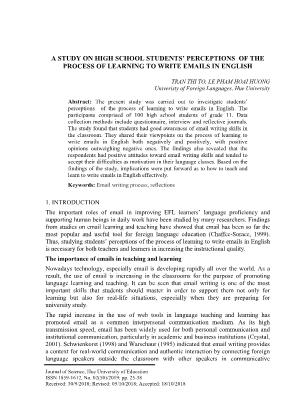
Journal of Science, Hue University of Education ISSN 1859-1612, No. 02(50)/2019: pp. 25-38 Received: 30/9/2018; Revised: 05/10/2018; Accepted: 18/10/2018 A STUDY ON HIGH SCHOOL STUDENTS’ PERCEPTIONS OF THE PROCESS OF LEARNING TO WRITE EMAILS IN ENGLISH TRAN THI TO, LE PHAM HOAI HUONG Univeristy of Foreign Languages, Hue University Abstract: The present study was carried out to investigate students’ perceptions of the process of learning to write emails in English. The participants comprised of 100 high school students of grade 11. Data collection methods include questionnaire, interview and reflective journals. The study found that students had good awareness of email writing skills in the classroom. They shared their viewpoints on the process of learning to write emails in English both negatively and positively, with positive opinions outweighing negative ones. The findings also revealed that the respondents had positive attitudes toward email writing skills and tended to accept their difficulties as motivation in their language classes. Based on the findings of the study, implications were put forward as to how to teach and learn to write emails in English effectively. Keywords: Email writing process, reflections 1. INTRODUCTION The important roles of email in improving EFL learners’ language proficiency and supporting human beings in daily work have been studied by many researchers. Findings from studies on email learning and teaching have showed that email has been so far the most popular and useful tool for foreign language education (Chaffee-Sorace, 1999). Thus, studying students’ perceptions of the process of learning to write emails in English is necessary for both teachers and learners in increasing the instructional quality. The importance of emails in teaching and learning Nowadays technology, especially email is developing rapidly all over the world. As a result, the use of email is increasing in the classrooms for the purpose of promoting language learning and teaching. It can be seen that email writing is one of the most important skills that students should master in order to support them not only for learning but also for real-life situations, especially when they are preparing for university study. The rapid increase in the use of web tools in language teaching and learning has promoted email as a common interpersonal communication medium. As its high transmission speed, email has been widely used for both personal communication and institutional communication, particularly in academic and business institutions (Crystal, 2001). Schwienkorst (1998) and Warschaur (1995) indicated that email writing provides a context for real-world communication and authentic interaction by connecting foreign language speakers outside the classroom with other speakers in communicative 26 TRAN THI TO, LE PHAM HOAI HUONG situations. In the context of the classroom, email provides immediate feedback and allows students to discuss and communicate directly and cheaply with key pals around the world (Hoffman, 1994). Email is also a useful tool for students to improve their English writing skills. According to Alias and Hussin (2002), web- based activities such as searching for information, exchanging of messages via email and participating in discussion groups are helpful to learners in their writing process. Accordingly, the students can enrich their knowledge about the world and foster their writing ideas. What’s more, speed, power, and flexibility of the computer and email can effectively facilitate their second language acquisition, and then help students raise their awareness of learning writing. More importantly, developing email writing skill is especially necessary for English language students at the secondary stage. In terms of developing the overall ability of writing for high school students, they have to learn how to write emails in English. It can be said that the secondary level of education is a stage of consolidation, supporting and reinforcing English language basics previously learnt by students during the preparatory stage (Abdel-Razek, 2006). By using emails, they also become familiar with a communication tool that is vital to their survival in the 21st century. Thus, mastering writing skills during the high school study helps students’ progress in their university studies (El-Shafie, 2006). Students’ reflections on the process of email writing Reflection is a term which has been much used in the educational literature over the past decade (Boud, Keogh, & Walker, 1985). Among many various definitions about reflection, Boud et al. (1985) shared the definitions with some common features and these are worth considering in more detail. Reflective thought was defined as active, persistent and careful consideration of any belief or supposed form of knowledge in the light of the grounds that support it and the further evidence by which the reliability and worth of a belief can be established so as to justify its acceptance. It is clear that an important outcome of the reflection process is changing one’s perspective as new information and experiences are encountered (Hay et al., 2004a). The reflection processes not only involve in the self but the outcomes of reflection also lead into a changed conceptual perspective, which helps learners understand the relationship between their learning and problem-solving goals. In the light of developing one’s knowledge and skills, reflection can be considered as a learning tool and action process has long been seen as a crucial prerequisite to effective decision making, especially in decision environments that contain ambiguous problems, unique elements, and no defined solutions (Pee et al., 2000; Schon, 1987). Therefore, it supports to revise extant understanding or to construct new meanin ... themselves, how they worked together in order to write a good email. The study showed the students’ efforts in developing their email writing skill though there were still some weak points in group or pair discussions. The following table displays the results of the study on teacher’s feedback on students’ email writings. 34 TRAN THI TO, LE PHAM HOAI HUONG Table 5. Teacher’s feedback on students’ email writings N= 100 Min Max Mean SD 18.The teacher should give you feedback by a grade or mark only 1 5 2.61 1.15 19.The teacher gives you feedback by a grade or mark first, then comments. 1 5 3.25 1.17 20.The teacher gives you feedback by comments first, then a garde or mark. 1 5 3.78 1.07 21.The teacher gives you feedback by comments only. 1 5 3.35 1.14 Table 5 demonstrates students’ expectation in receiving feedback from their teachers. As depicted in Table 5, most of the mean scores were over than 3 (ranging from 3.25 to 3.78), indicating the respondents mostly have a high agreement on teacher’s feedback. However, with the value of 2.61 for item 18, showing the disagreement level was not low as well. In other aspect, all the standard deviation range from 1.079 to 1.175 implying that the responses spread out from the mean scores remarkably. As showed in Table 5, many students did not want to be given feedback by a grade or mark only (item 18, M = 2.61). A male student shows that he did not care of how many grades he had received because it might make him become more dependent on the final results and ignore the main goal of learning English. He responded in the interview, “I did not want to focus on marks so much; I hoped to receive comments from my teacher to foster my writing skill rather than marks only. The comments provided me with useful advice that I could improve my email later”. Similarly, another student shared in her reflective journal that comments were better than grades because it was comments that could help the student recognize the real strengths and weakness. She wrote: “One of the reasons why I did not like grades or marks only was that many students did not realize what were good or bad in the email writings, they just focused on the final results and satisfied with what they had done”. However, not all feedback is the same and not all feedback is equally effective in promoting learning (Black & William, 1998). When being asked about this issue, a female student said that marks or grades were the standard, which could be used to measure whether the student was good or bad. She expressed in the interview, “I thought that grades should be a standard used to assess the students’ level. As you could see that our final results at the end of each term was assessed by grades. Each student should be aware of their own learning through grades that they got from their teacher”. To the item 20 (M= 3.78), many participants strongly agreed that both comments and grades or marks were really fundamental to them. Comments could help the students recognize their limitations or strengths, and then they could adjust their learning strategies more appropriately. Meanwhile, grades or marks could be considered the final results, which motivated them in learning and achieving higher levels. The analysis indicated that feedback by comments strongly influenced students’ A STUDY ON HIGH SCHOOL STUDENTS’ PERCEPTIONS OF THE PROCESS... 35 subsequent performance. Receipt of a low grade might lead to a substantial decline in writing performance by students who thought the grade has come from the instructor, but a praise or positive comment from the instructor appeared to ameliorate students’ motivation to learn to write emails. However, in the absence of detailed feedback, a grade appeared to enhance subsequent performance just modestly. These statistics also imply that the teachers should be more flexible in giving feedback to their students and try to leave some comments on good points, bad points so that students can clearly understand what should be done to improve their email writing. 4. CONCLUSION This research adopts questionnaire, interview and reflective journals to study students’ perceptions, reflections and the actual process of learning to write emails in English. Several conclusions can be drawn from the findings of the study. Firstly, the study found that high school students in this study had good awareness in foreign language learning. They showed their positive attitudes toward email learning and the process of teaching how to write email as well. They seemed to be more concerned about teacher’s methods in guiding them how to write emails (M=3.7914) than the other aspects when learning email writing. Secondly, the students shared their viewpoints on the process of learning to write emails in English both negatively and positively, with positive opinions outweighing negative ones. The mismatch between teacher’s methods and learner’s style of learning sometimes made students get bad results for email writing because they had a great deal of difficulties in grasping language knowledge of email writing and focusing on language classes. The students also indicated that they always tried their best to improve their email writing skills thanks to their teachers' and classmates’ supports. However, not all students had the same attitudes toward this email writing process. Some of them mentioned negative aspects, which affected students’ participation in email writing activities, and then they became inactive, unconfident and timid to raise their voice in writing classes. Thirdly, the study implies that some difficulties in language knowledge and inappropriate methods of teaching and learning made students unable to write good emails in English, which results in their poor performance. One of the difficulties that students considered to be the most problematic for them was lacking of vocabulary and grammar. In addition, fear of negative feedbacks made students passive in email writing classes; however, it also created learning motivation for some students. Pedagogical Implications From the findings of this study, several implications are put forward to both teachers and students regarding the process of learning to write emails in English. For teachers: - Teachers should consider email writing as an important skill in the classroom and try to 36 TRAN THI TO, LE PHAM HOAI HUONG make it become a very familiar and useful tool for all students. It is important for teachers to often ask the students carefully about their difficulties in email writing lessons. Additionally, teachers can base on the way students write their emails to determine what problems they are facing with. Finding out students’ problems can help teachers deal with students’ difficulties in learning to write emails in English more easily. - Teachers' attitudes and expectations are also important factors in L2 writing classrooms (Williams, 2003). Therefore, in order to be more effective, teachers must feel good about teaching and about students and believe that they can influence students’ learning (Proctor, 1984). In addition, teachers should pay attention to enriching their personalities such as humor, friendliness, tolerance and patience, which can help students feel less anxious and more motivated in learning to write emails (Young, 1991). It is believed that good teachers know how to adjust their emotion and reduce negative evaluation to students’ mistakes, which enhances students’ learning and motivation as well. - The teacher should create a learner-centered learning environment in which students can develop their abilities in their classroom. Pair work, small group work, stimulations and structured exercises should be employed to encourage students to communicate and interact. The importance is that teacher should encourage students to think, plan, and search for ideas, develop, organize, review their writing and above all meet the requirements of examinations and academic life. - Teachers should combine between theory and practice by giving students chances to exchange information through daily emails and cooperate with students to deal with their difficulties. Furthermore, many students expressed that they were afraid of making mistakes and losing face in front of the class, which stops them from expressing their ideas. Having positive attitudes towards making mistakes in writing lessons can help students deal with this problem. For students: - Students need to take their active role in learning to write emails in English and enthusiastically participating in writing activities in class. In order to become confident in writing lessons, students should be fully aware of self-study and should not depend on the teacher. - Students should recognize and accept their obstacles in email writing and consider these obstacles to be motivation that makes them try more in language learning. Besides, it is necessary for them to consult advice from teachers and other students to have effective learning methods. - They should have positive attitudes toward their email learning and writing in English. It is a good way for them to combine many different ways of leaning such as: group work, pair work, online learning on websites or from other sources. This will help students be more and more familiar with email writing and can feel less and less nervous. Especially, in the era of technology 4.0, the approach of many effective A STUDY ON HIGH SCHOOL STUDENTS’ PERCEPTIONS OF THE PROCESS... 37 learning methods support students in dealing with difficulties easily by combining what they have learnt at school and their practice in daily life. To sum up, the current study employed questionnaire in order to collect students’ opinions about the process of learning to write emails in English. The results from interview and reflective journals were briefly reported in the study because of the scope of the paper. Further studies can be carried out with a larger sample with more students of diverse backgrounds so as to increase the reliability, and discover more generalized findings that can be applicable in different settings. It is also worth investigating the improvement of students’ email writing in longitudinal studies. REFERENCES [1] Abdel-Razek, T. (2006). The effectiveness of the genre-based approach in developing the writing skills for EFL first year secondary school students. Unpublished M.A. Thesis, Faculty of Education, Menoufia University, Egypt. [2] Alias, N., Hussin, S. (2002). "E-learning in a writing course at Tenaga National University". TEFL Web Journal.1 (3). Retrieved August 1, 2018, from Alias_Hussin.htm. [3] Bell, J. (1993). Doing Your Research Project. Buckingham, Philadelphia: Open. [4] Black, P., & William, D. (1998). Assessment and classroom learning. Assessment in Education: Principles, Policy & Practice, 5(1), 7-68. [5] Boud, D., Keogh, R., & Walker, D. (1985). Reflection: Turning experience into learning. London: Kogan Page. [6] Chaffee-Sorace, D. (1999). Computer pen pals: Writing activities for subjects of foreign languages. Canadian Modern Language Review, 56(2), 351-354. [7] Crystal, D. (2001). Language and the Internet. Cambridge: Cambridge University Press. [8] El-Shafie, S. (2006). The effectiveness of using computers in improving English composition writing for secondary stage students. Unpublished M.A. Thesis. Faculty of Education, Menoufia University. [9] Foster, J. Greenwood, J. (1998). Reflection a challenging innovation for nurses. Contemporary Nurse. 7 [41:165-172. [10] Hay, A., Peltier, J.W., & Drago, W.A. (2004a). Reflective learning and on-line management education: A comparison of traditional and on-line MBA students. Strategic Change, 13(4): 169-182. [11] Hoffman, R. (1994). Powerful, personal: Electronic mail and the L2 writing process. ReCALL Journal, 6(2), 53-62. [12] Maclellan, E. (2004). How effective is the academic essay? Studies in Higher Education, 29 (1): 75-89. [13] Mansor, N. (2007). Collaborative learning via email discussion: strategies for ESL writing classroom. The Internet TESL Journal, 13(3). [14] McAlpine L., Frew E. & Lucas, M. (1991). Mechanisms for helping becoming practitioners develop professional ways of knowing. In M. Baskett, V.J. Marsick, T.G. Pearson, D.R. Klevans & J. Delehanty, eds, Proceedings of the Continuing Education Preconference of the American Association of Adult and Continuing Education, pp. 67–73. University Park: Penn State University. 38 TRAN THI TO, LE PHAM HOAI HUONG [15] Pee B., Woodman T., Fry H., & Davenport, E.S. (2000). Practice-based learning: Views in the development of a reflective learning tool. Medical Education, 34: 754- 761. [16] Proctor, C. (1984). Teacher expectations: A model for school improvement. Elementary School Journal, 84(4), 469-481. [17] Schön, D.A. (1987). Educating the Reflective Practitioner. San Francisco, CA: Jossey-Bass. [18] Schwienkorst, K..(1998). "The third place" -virtual reality applications for second language learning. Recall, 10(1), 18-126. Warschauer, M., E-mail for English teaching. Alexandria, VA: TESOL. [19] Tallon, M. (2008). A Culture of Caring: Reducing Anxiety and Increasing Engagement. The Collaborating for Student success: Building Engagement in learning (pp. 1 -20). San Antonio, TX: University of Incarnate Word. [20] Young, D. J. (1991). Creating a Low-Anxiety Classroom Environment: What Does Language Anxiety Research Suggest? The Modern Language Journal, 75, 426-439. [21] Williams, J. D. (2003). Preparing to teach writing: Research, theory, and practice. London: Routledge.
File đính kèm:
 a_study_on_high_school_students_perceptions_of_the_process_o.pdf
a_study_on_high_school_students_perceptions_of_the_process_o.pdf

